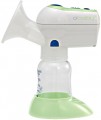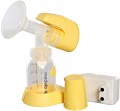Type
The type determines the general principle of operation of the breast pump and its key features.
-
Electric. Breast pumps equipped with built-in motors powered by mains or batteries (see "Power"). The main advantage of such devices over mechanical ones is simplicity and ease of use. There is no need to manually pump the lever, pull the piston or squeeze the pear: mom just needs to attach the nozzle to her chest and press the power button. Among the electric models, there are very advanced devices - for example, with attachments for both breasts, two-phase intensity, and even
a remote control(see "Advanced"). Yes, and the impact of such breast pumps are more delicate. The main disadvantage of electric models is the high price. It is also worth considering that the motor is quite noisy, and you need to turn it on with caution so as not to disturb the baby.
-
Mechanical. Breast pumps operated by hand. There are several varieties of such devices, they are described in detail below, in the "Type" section. Here we note that the main advantages of mechanical models over electric ones are simplicity, low cost, minimum noise and independence from sockets / batteries. On the other hand, the use of a mechanical breast pump can be quite tedious, in such models it is difficult to provide additional functions such as two-phase pumping (see "Additional"), and some typ
...es of "mechanics" quite intensely affect the breast, which leads to discomfort and even cracks nipples. So it is worth paying attention to this variety first of all if the breast pump should be inexpensive and quiet. In turn, mechanical is divided into categories:
- Piston. A breast pump equipped with a piston and working on the principle of a syringe: to suck milk, you need to pull the piston, creating a vacuum inside. The main advantages of piston models are compactness, simplicity, low cost and ease of cleaning and sterilization. At the same time, the use of such a device is not very convenient: you need to hold the nozzle at the chest and at the same time pull the piston with force. The mother may simply “not have enough hands” for this, and effective pumping often requires the help of another person. On the other hand, by changing the speed of the piston, it is possible to change the suction intensity.
- With a pear. The breast pump having in a design an elastic pear. Also, such models are called "pump-action". During operation, the pear must often be squeezed by hand, creating the necessary vacuum inside the device. Such devices are somewhat more convenient than piston ones; a mother can easily handle such a breast pump on her own; and they are inexpensive. At the same time, such models can hardly be called comfortable: inflating a pear can be quite a tedious task, and the efficiency and speed of pumping often leave much to be desired. In addition, pump-action breast pumps are not distinguished by delicacy; frequent use of such a device is fraught with discomfort and even nipple cracks.
- Lever. The most advanced type of mechanical breast pumps. A distinctive feature of such devices is the lever, which, when used, must be pumped, pressing the nozzle to the chest. Some devices allow you to do all this with one hand. In addition, the articulated model can be made two-phase (see "Advanced"). In general, such breast pumps are quite comfortable, and less tiring than pump pumps. Due to all this, this variety is the most popular today.
And electric (sometimes mechanical) have a different number of phases for better pumping:
- Biphasic. Two-phase breast pump: first, the device stimulates the nipple to produce milk, then pumps out the secreted milk. This way of working is considered the most natural, closest to how a baby sucks milk. Most devices with this function are electrical, but there are also mechanical models. Also note that switching between modes usually needs to be done manually.
Number of phases
—
Two-phase. Two-phase models imitate the baby’s natural behavior when sucking the breast: first, the device “pulls” often and lightly, stimulating lactation, then with less frequency, but more strongly, when the milk has already started flowing. Modes are switched manually - so mom can independently change the settings at the most appropriate moment.
—
Three-phase. Such breast pumps are essentially similar to two-phase ones (see the corresponding paragraph), however, the stages of stimulation and expression in them are supplemented by a third phase - the so-called hardening. It turns on during the final stages of breastfeeding to help clean the nipple and increase lactation.
Power source
The type of supply provided in the electric breast pump (see "View").
There are two main power options — from the mains (from the outlet) and from batteries; each of them has its own advantages and disadvantages. So, when connected to a power outlet, the operating time is almost unlimited, but the electric wire limits mobility and can get confused, creating inconvenience. Batteries, in turn, allow you to work even in the complete absence of sockets and make it possible to easily transfer the device from place to place, but the operating time from such power is limited, dead batteries need to be changed or recharged.
Most modern breast pumps use both types of feed. This makes it possible to choose the most convenient option in a given situation: for example, at home you can easily connect the device to a power outlet, and when traveling, batteries can come in handy. However, there are also models powered only by mains or only by batteries. You should pay attention to such devices if the disadvantages of one or another option are not critical for you (for example, if you plan to use the breast pump only at home where there are sockets).
In box
-
Massage pad. Overlay of a special form, which provides an additional massage effect on the chest. This pad improves the overall efficiency of the device, stimulates milk flow more, and can reduce the discomfort of pumping. Note that the specific forms of massage nozzles may be different.
—
Overlays of different sizes. The set includes several interchangeable pads with different sizes. This allows you to choose the size of the pad for the anatomical features of the chest. Such equipment is especially useful in cases where the mother’s breasts are noticeably different from the “average” ones - for example, if it is small, or vice versa, massive, with large nipples.
-
Milk storage bag. The presence of a bag for milk in the delivery set of the device. Such a package can be hermetically fastened; it is useful primarily for storing breast milk in the refrigerator, including for freezing.
-
Milk container. The presence of a container for milk in the delivery set of the device. In fact, in this case we are talking about a bottle (or several bottles) supplied in addition to the main container. This configuration is convenient in that the bottles can be alternated - for example, use one while the other dries after washing.
-
Bottle adapter. The presence of an adapter fo
...r bottles in the delivery set of the device. Baby milk bottles are available in two versions - with a wide and narrow neck, and various accessories are made to fit these sizes, including breast pump nozzles. The specific type of adapter may vary: in some cases it is designed to use a “narrow” nozzle with a wide bottle, in others it is vice versa. However, in any case, we can say that with the presence of an adapter, the breast pump will be compatible with both types of bottles - both narrow and wide.
- pacifier. The presence of a pacifier in the delivery set of the device. Such a nipple is convenient in that it is ideal for the bottle supplied in the kit. Thus, having bought a breast pump with a nipple and a container, you have at your disposal everything you need to feed your baby with expressed milk.
- Bag / case. The presence of a bag or cover in the delivery set of the device. A bag is commonly referred to as a soft pack with a handle or strap for easy portability; the case is somewhat simpler, it does not have a handle and is designed to be carried in a travel bag, backpack, etc. However, both types of packaging can be very useful during storage and transportation: a bag / case closes the device from dust and other contaminants, ensuring hygiene, and also protects the contents to some extent from bumps and dirt. In addition, in a bag or case you can keep not only the breast pump itself, but also additional accessories for it.
- Bra pads. Presence of inserts for a bra in a delivery set of the device. Such an insert, in fact, is a sanitary napkin designed to dry the breast after feeding or pumping. Excess milk entering the bra causes discomfort and can even lead to the development of a breast infection; the liner effectively absorbs moisture and prevents unpleasant consequences. Complete wipes can be disposable or reusable, this point should be clarified before buying. We also note that the inserts are sold on their own, however, it is more convenient to buy them immediately, together with a breast pump, than separately.Country of origin
The country of origin of the brand under which the product is marketed. Often indicated by the nationality of the company or the location of its headquarters. At the same time, the actual production capacity of the brand often differs from the country of origin.
It should be noted that the quality of products depends not so much on geography, but on the peculiarities of the organization of processes and quality control at all stages of production. Therefore, national prejudices regarding brands from certain regions, as a rule, are not supported by anything. It is necessary to pay attention to the country of origin of the brand only if the task is to fundamentally support or bypass the manufacturer from a particular state.

